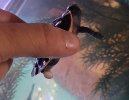My young Pink Belly Sideneck was shipped from Florida to me, in Illinois, with a prolapse. The turtle is robust and healthy and is eating on a daily basis.
Initially, the prolapse would only occur following a feeding. I've had the turtle for about 3 weeks now, and the prolapse appears to now be ever-present. The turtle shows no signs of illness, but it has been extremely timid. I do wonder if the prolapse is influencing this timid behavior.
I've kept turtles for over 30 years. This is my first experience with a prolapse that is not related to the turtles sexual organs - this appears to be intestine. It's a bubble with red veins running through it.
I feel that this may be due to a congenital defect; the vent of the turtle appears to be open at all times, even when the prolapse is retracted within the body. I think that this may be a chronic issue for this turtle, and based on the turtle's overall health, my guess is that the turtle can live a normal healthy life but will of course require exceptional water quality and husbandry. I will attach a picture.
I've had the turtle for 3 weeks and other than being very timid, it is healthy, thriving and eating. It's too small to take to a veterinarian. The prolapse can be massaged back in, but it doesn't seem to be a solution so I'm no longer entertaining that idea.
Any advice is much appreciated.
Thanks!
Mitch
Initially, the prolapse would only occur following a feeding. I've had the turtle for about 3 weeks now, and the prolapse appears to now be ever-present. The turtle shows no signs of illness, but it has been extremely timid. I do wonder if the prolapse is influencing this timid behavior.
I've kept turtles for over 30 years. This is my first experience with a prolapse that is not related to the turtles sexual organs - this appears to be intestine. It's a bubble with red veins running through it.
I feel that this may be due to a congenital defect; the vent of the turtle appears to be open at all times, even when the prolapse is retracted within the body. I think that this may be a chronic issue for this turtle, and based on the turtle's overall health, my guess is that the turtle can live a normal healthy life but will of course require exceptional water quality and husbandry. I will attach a picture.
I've had the turtle for 3 weeks and other than being very timid, it is healthy, thriving and eating. It's too small to take to a veterinarian. The prolapse can be massaged back in, but it doesn't seem to be a solution so I'm no longer entertaining that idea.
Any advice is much appreciated.
Thanks!
Mitch
